Creativity and Innovation
VerifiedAdded on 2023/02/01
|16
|3960
|87
AI Summary
This essay analyzes the concepts of creativity and innovation in modern organizations. It explores the differences between the two concepts and how they complement each other. Examples of creative and innovative organizations are discussed.
Contribute Materials
Your contribution can guide someone’s learning journey. Share your
documents today.
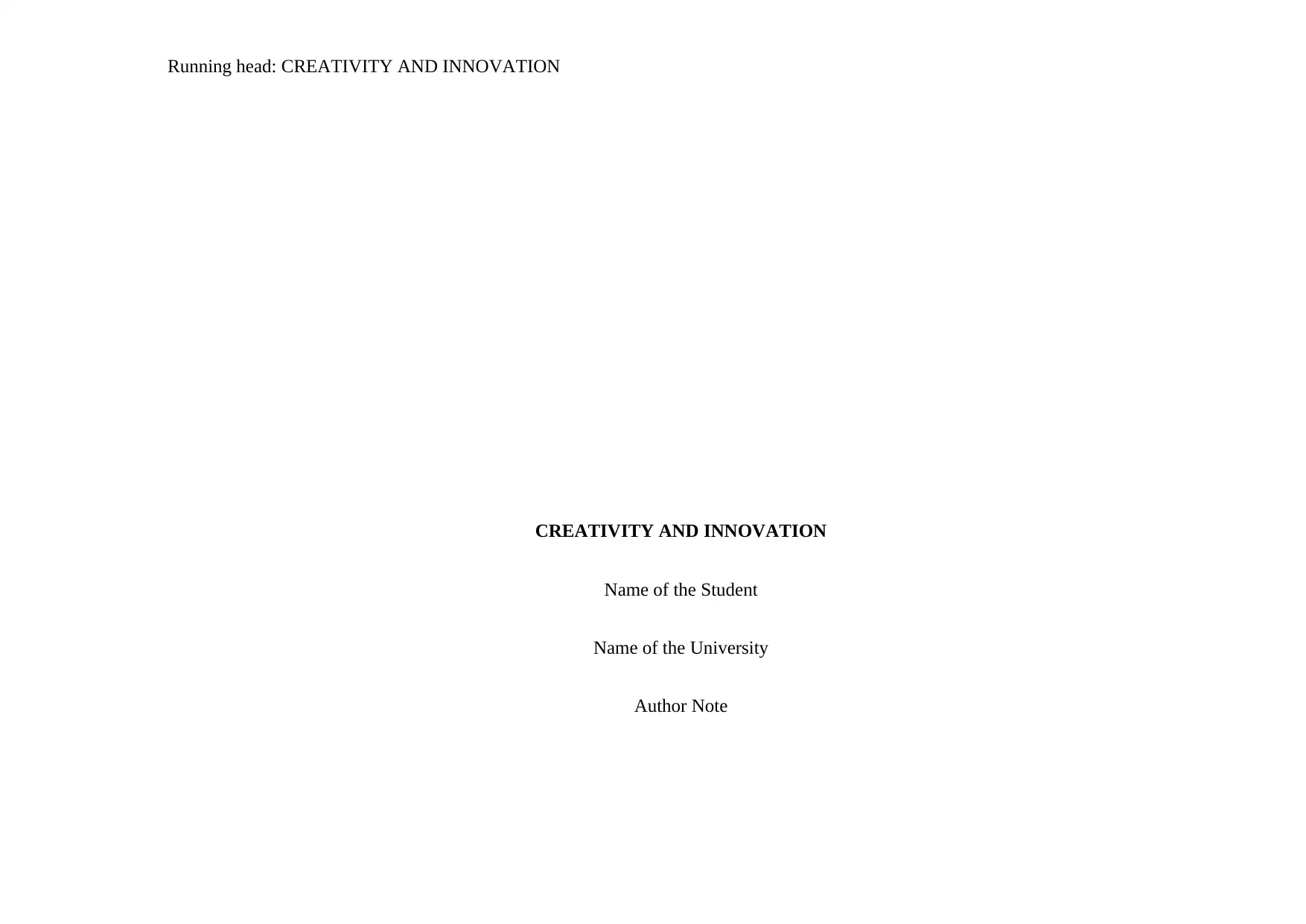
Running head: CREATIVITY AND INNOVATION
CREATIVITY AND INNOVATION
Name of the Student
Name of the University
Author Note
CREATIVITY AND INNOVATION
Name of the Student
Name of the University
Author Note
Secure Best Marks with AI Grader
Need help grading? Try our AI Grader for instant feedback on your assignments.
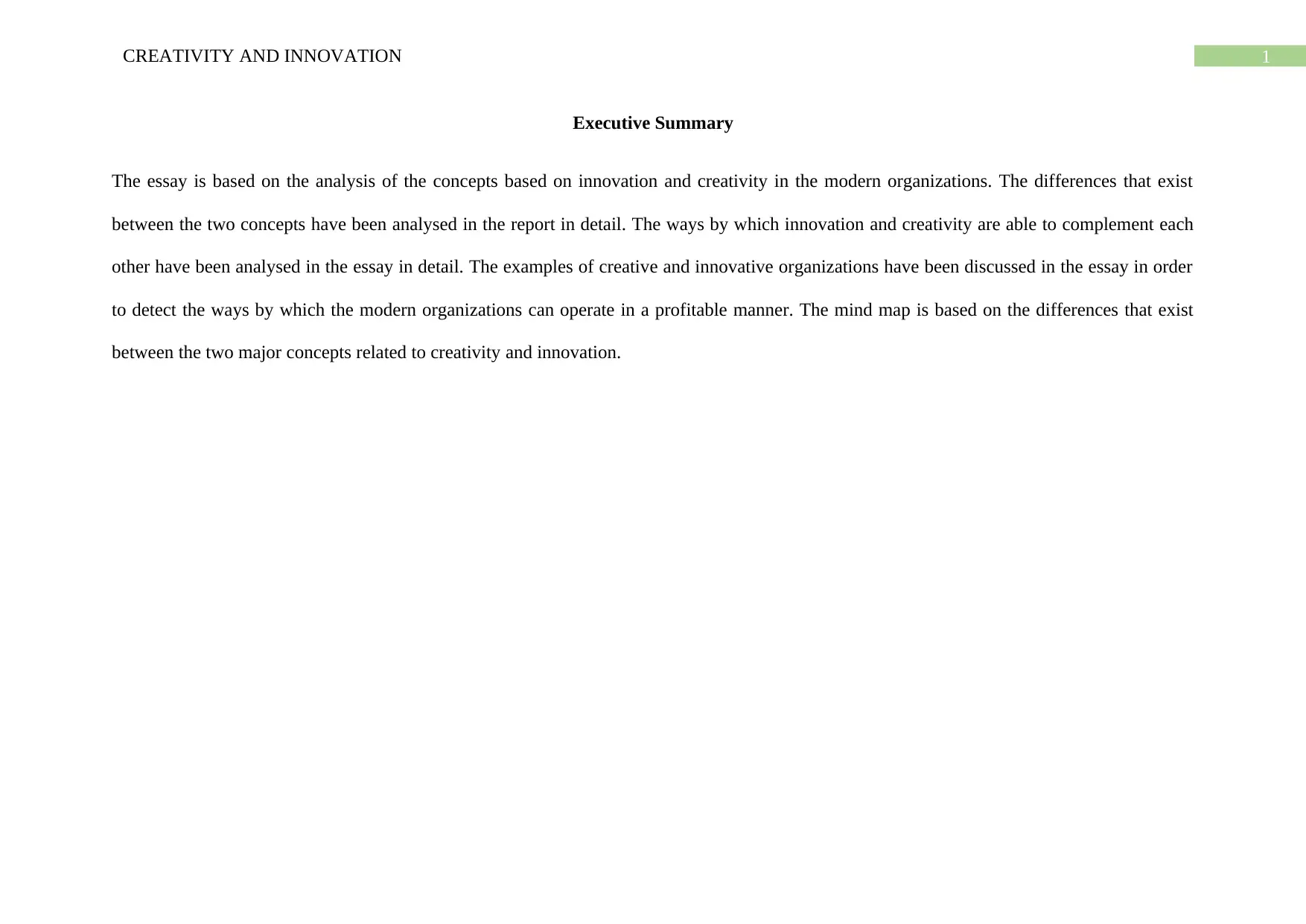
1CREATIVITY AND INNOVATION
Executive Summary
The essay is based on the analysis of the concepts based on innovation and creativity in the modern organizations. The differences that exist
between the two concepts have been analysed in the report in detail. The ways by which innovation and creativity are able to complement each
other have been analysed in the essay in detail. The examples of creative and innovative organizations have been discussed in the essay in order
to detect the ways by which the modern organizations can operate in a profitable manner. The mind map is based on the differences that exist
between the two major concepts related to creativity and innovation.
Executive Summary
The essay is based on the analysis of the concepts based on innovation and creativity in the modern organizations. The differences that exist
between the two concepts have been analysed in the report in detail. The ways by which innovation and creativity are able to complement each
other have been analysed in the essay in detail. The examples of creative and innovative organizations have been discussed in the essay in order
to detect the ways by which the modern organizations can operate in a profitable manner. The mind map is based on the differences that exist
between the two major concepts related to creativity and innovation.
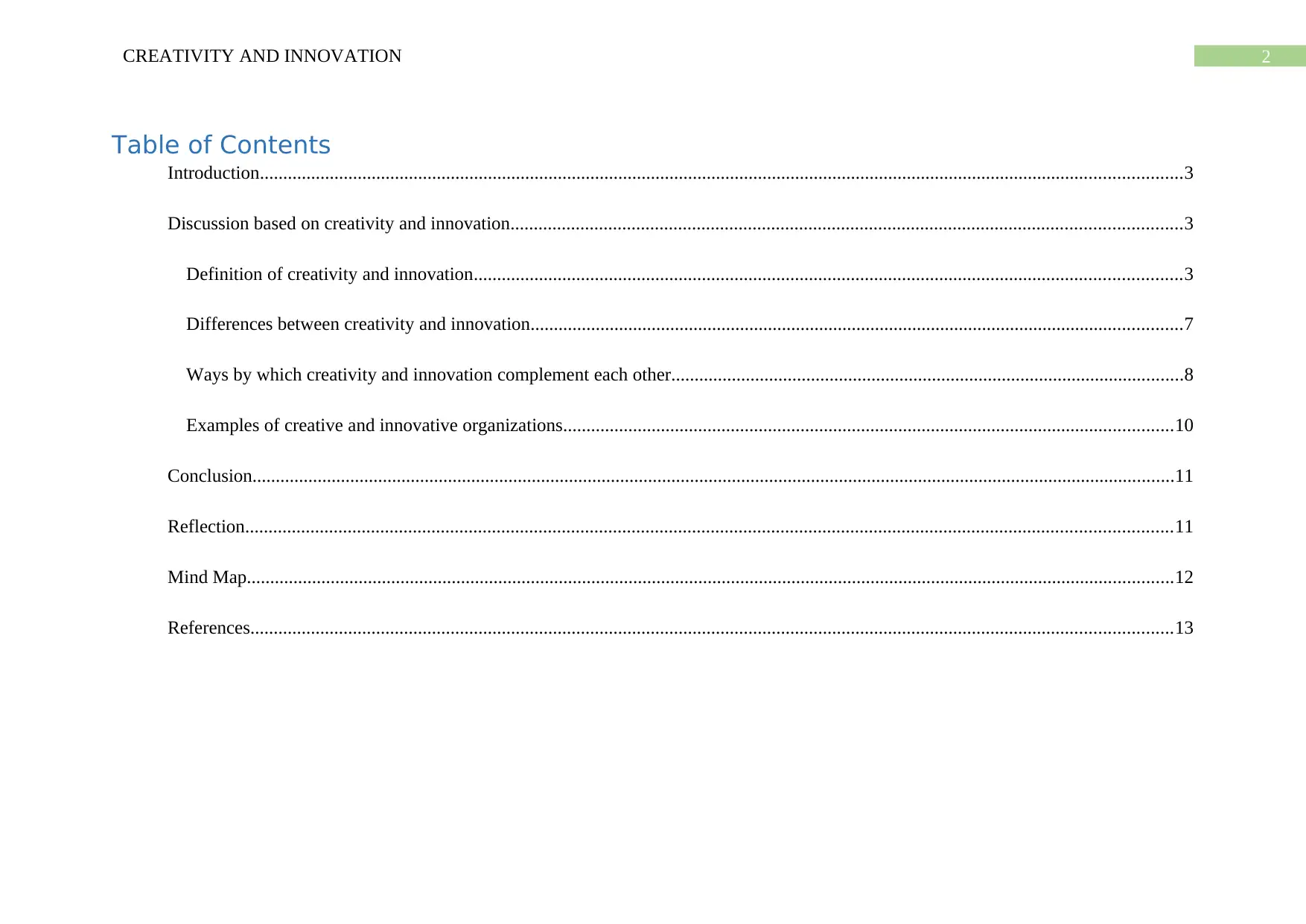
2CREATIVITY AND INNOVATION
Table of Contents
Introduction......................................................................................................................................................................................................3
Discussion based on creativity and innovation................................................................................................................................................3
Definition of creativity and innovation........................................................................................................................................................3
Differences between creativity and innovation............................................................................................................................................7
Ways by which creativity and innovation complement each other..............................................................................................................8
Examples of creative and innovative organizations...................................................................................................................................10
Conclusion......................................................................................................................................................................................................11
Reflection.......................................................................................................................................................................................................11
Mind Map.......................................................................................................................................................................................................12
References......................................................................................................................................................................................................13
Table of Contents
Introduction......................................................................................................................................................................................................3
Discussion based on creativity and innovation................................................................................................................................................3
Definition of creativity and innovation........................................................................................................................................................3
Differences between creativity and innovation............................................................................................................................................7
Ways by which creativity and innovation complement each other..............................................................................................................8
Examples of creative and innovative organizations...................................................................................................................................10
Conclusion......................................................................................................................................................................................................11
Reflection.......................................................................................................................................................................................................11
Mind Map.......................................................................................................................................................................................................12
References......................................................................................................................................................................................................13
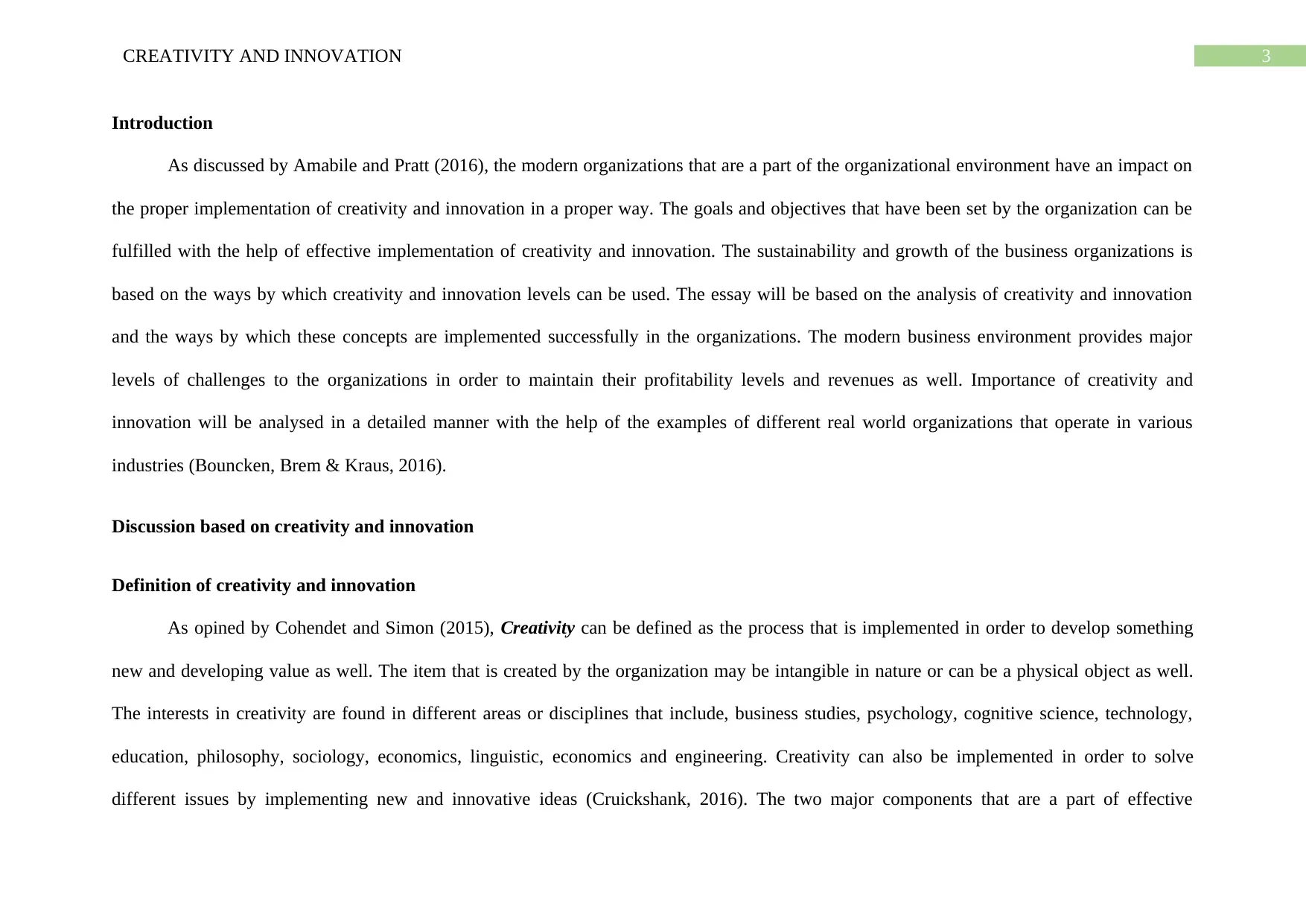
3CREATIVITY AND INNOVATION
Introduction
As discussed by Amabile and Pratt (2016), the modern organizations that are a part of the organizational environment have an impact on
the proper implementation of creativity and innovation in a proper way. The goals and objectives that have been set by the organization can be
fulfilled with the help of effective implementation of creativity and innovation. The sustainability and growth of the business organizations is
based on the ways by which creativity and innovation levels can be used. The essay will be based on the analysis of creativity and innovation
and the ways by which these concepts are implemented successfully in the organizations. The modern business environment provides major
levels of challenges to the organizations in order to maintain their profitability levels and revenues as well. Importance of creativity and
innovation will be analysed in a detailed manner with the help of the examples of different real world organizations that operate in various
industries (Bouncken, Brem & Kraus, 2016).
Discussion based on creativity and innovation
Definition of creativity and innovation
As opined by Cohendet and Simon (2015), Creativity can be defined as the process that is implemented in order to develop something
new and developing value as well. The item that is created by the organization may be intangible in nature or can be a physical object as well.
The interests in creativity are found in different areas or disciplines that include, business studies, psychology, cognitive science, technology,
education, philosophy, sociology, economics, linguistic, economics and engineering. Creativity can also be implemented in order to solve
different issues by implementing new and innovative ideas (Cruickshank, 2016). The two major components that are a part of effective
Introduction
As discussed by Amabile and Pratt (2016), the modern organizations that are a part of the organizational environment have an impact on
the proper implementation of creativity and innovation in a proper way. The goals and objectives that have been set by the organization can be
fulfilled with the help of effective implementation of creativity and innovation. The sustainability and growth of the business organizations is
based on the ways by which creativity and innovation levels can be used. The essay will be based on the analysis of creativity and innovation
and the ways by which these concepts are implemented successfully in the organizations. The modern business environment provides major
levels of challenges to the organizations in order to maintain their profitability levels and revenues as well. Importance of creativity and
innovation will be analysed in a detailed manner with the help of the examples of different real world organizations that operate in various
industries (Bouncken, Brem & Kraus, 2016).
Discussion based on creativity and innovation
Definition of creativity and innovation
As opined by Cohendet and Simon (2015), Creativity can be defined as the process that is implemented in order to develop something
new and developing value as well. The item that is created by the organization may be intangible in nature or can be a physical object as well.
The interests in creativity are found in different areas or disciplines that include, business studies, psychology, cognitive science, technology,
education, philosophy, sociology, economics, linguistic, economics and engineering. Creativity can also be implemented in order to solve
different issues by implementing new and innovative ideas (Cruickshank, 2016). The two major components that are a part of effective
Secure Best Marks with AI Grader
Need help grading? Try our AI Grader for instant feedback on your assignments.
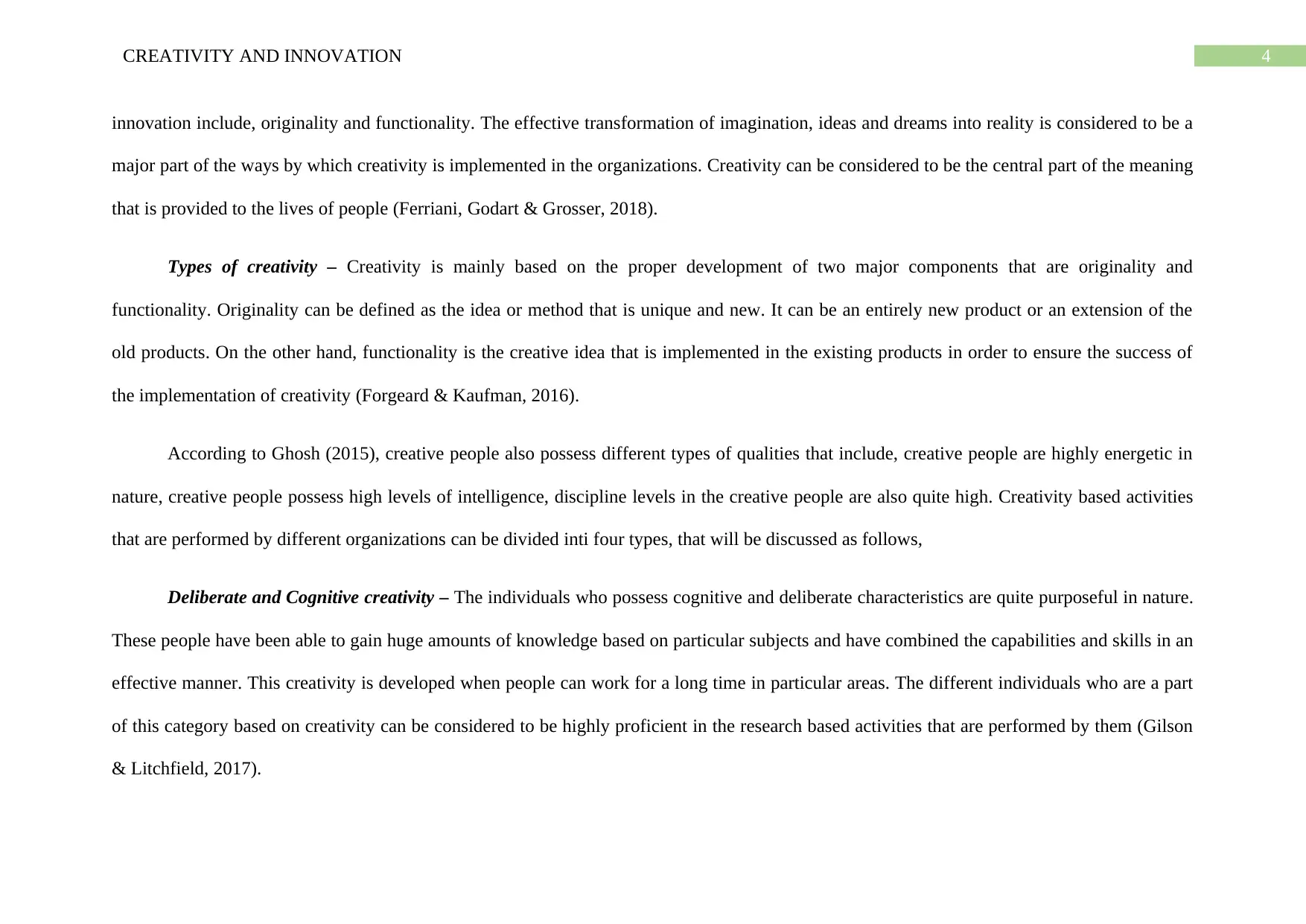
4CREATIVITY AND INNOVATION
innovation include, originality and functionality. The effective transformation of imagination, ideas and dreams into reality is considered to be a
major part of the ways by which creativity is implemented in the organizations. Creativity can be considered to be the central part of the meaning
that is provided to the lives of people (Ferriani, Godart & Grosser, 2018).
Types of creativity – Creativity is mainly based on the proper development of two major components that are originality and
functionality. Originality can be defined as the idea or method that is unique and new. It can be an entirely new product or an extension of the
old products. On the other hand, functionality is the creative idea that is implemented in the existing products in order to ensure the success of
the implementation of creativity (Forgeard & Kaufman, 2016).
According to Ghosh (2015), creative people also possess different types of qualities that include, creative people are highly energetic in
nature, creative people possess high levels of intelligence, discipline levels in the creative people are also quite high. Creativity based activities
that are performed by different organizations can be divided inti four types, that will be discussed as follows,
Deliberate and Cognitive creativity – The individuals who possess cognitive and deliberate characteristics are quite purposeful in nature.
These people have been able to gain huge amounts of knowledge based on particular subjects and have combined the capabilities and skills in an
effective manner. This creativity is developed when people can work for a long time in particular areas. The different individuals who are a part
of this category based on creativity can be considered to be highly proficient in the research based activities that are performed by them (Gilson
& Litchfield, 2017).
innovation include, originality and functionality. The effective transformation of imagination, ideas and dreams into reality is considered to be a
major part of the ways by which creativity is implemented in the organizations. Creativity can be considered to be the central part of the meaning
that is provided to the lives of people (Ferriani, Godart & Grosser, 2018).
Types of creativity – Creativity is mainly based on the proper development of two major components that are originality and
functionality. Originality can be defined as the idea or method that is unique and new. It can be an entirely new product or an extension of the
old products. On the other hand, functionality is the creative idea that is implemented in the existing products in order to ensure the success of
the implementation of creativity (Forgeard & Kaufman, 2016).
According to Ghosh (2015), creative people also possess different types of qualities that include, creative people are highly energetic in
nature, creative people possess high levels of intelligence, discipline levels in the creative people are also quite high. Creativity based activities
that are performed by different organizations can be divided inti four types, that will be discussed as follows,
Deliberate and Cognitive creativity – The individuals who possess cognitive and deliberate characteristics are quite purposeful in nature.
These people have been able to gain huge amounts of knowledge based on particular subjects and have combined the capabilities and skills in an
effective manner. This creativity is developed when people can work for a long time in particular areas. The different individuals who are a part
of this category based on creativity can be considered to be highly proficient in the research based activities that are performed by them (Gilson
& Litchfield, 2017).
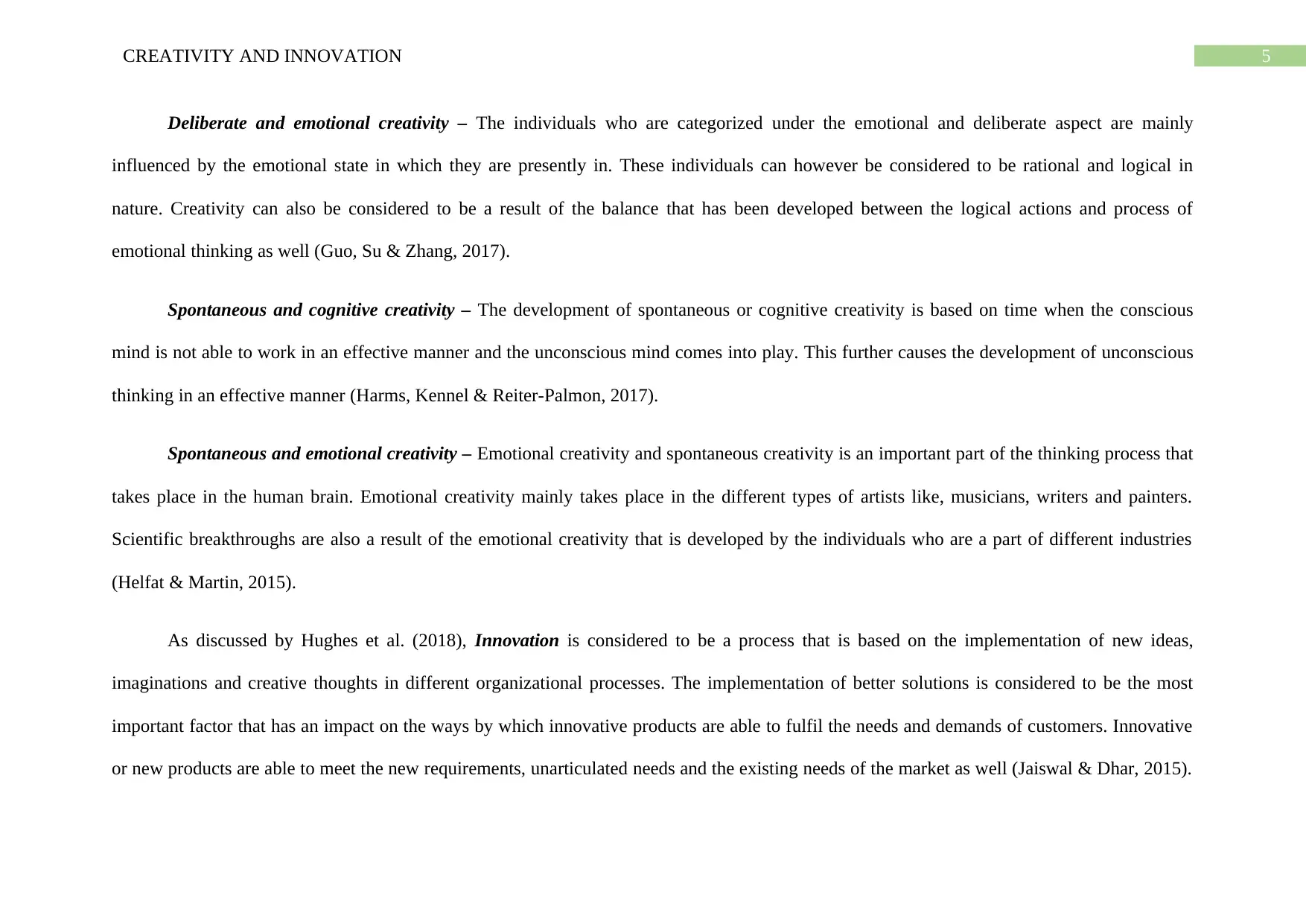
5CREATIVITY AND INNOVATION
Deliberate and emotional creativity – The individuals who are categorized under the emotional and deliberate aspect are mainly
influenced by the emotional state in which they are presently in. These individuals can however be considered to be rational and logical in
nature. Creativity can also be considered to be a result of the balance that has been developed between the logical actions and process of
emotional thinking as well (Guo, Su & Zhang, 2017).
Spontaneous and cognitive creativity – The development of spontaneous or cognitive creativity is based on time when the conscious
mind is not able to work in an effective manner and the unconscious mind comes into play. This further causes the development of unconscious
thinking in an effective manner (Harms, Kennel & Reiter-Palmon, 2017).
Spontaneous and emotional creativity – Emotional creativity and spontaneous creativity is an important part of the thinking process that
takes place in the human brain. Emotional creativity mainly takes place in the different types of artists like, musicians, writers and painters.
Scientific breakthroughs are also a result of the emotional creativity that is developed by the individuals who are a part of different industries
(Helfat & Martin, 2015).
As discussed by Hughes et al. (2018), Innovation is considered to be a process that is based on the implementation of new ideas,
imaginations and creative thoughts in different organizational processes. The implementation of better solutions is considered to be the most
important factor that has an impact on the ways by which innovative products are able to fulfil the needs and demands of customers. Innovative
or new products are able to meet the new requirements, unarticulated needs and the existing needs of the market as well (Jaiswal & Dhar, 2015).
Deliberate and emotional creativity – The individuals who are categorized under the emotional and deliberate aspect are mainly
influenced by the emotional state in which they are presently in. These individuals can however be considered to be rational and logical in
nature. Creativity can also be considered to be a result of the balance that has been developed between the logical actions and process of
emotional thinking as well (Guo, Su & Zhang, 2017).
Spontaneous and cognitive creativity – The development of spontaneous or cognitive creativity is based on time when the conscious
mind is not able to work in an effective manner and the unconscious mind comes into play. This further causes the development of unconscious
thinking in an effective manner (Harms, Kennel & Reiter-Palmon, 2017).
Spontaneous and emotional creativity – Emotional creativity and spontaneous creativity is an important part of the thinking process that
takes place in the human brain. Emotional creativity mainly takes place in the different types of artists like, musicians, writers and painters.
Scientific breakthroughs are also a result of the emotional creativity that is developed by the individuals who are a part of different industries
(Helfat & Martin, 2015).
As discussed by Hughes et al. (2018), Innovation is considered to be a process that is based on the implementation of new ideas,
imaginations and creative thoughts in different organizational processes. The implementation of better solutions is considered to be the most
important factor that has an impact on the ways by which innovative products are able to fulfil the needs and demands of customers. Innovative
or new products are able to meet the new requirements, unarticulated needs and the existing needs of the market as well (Jaiswal & Dhar, 2015).
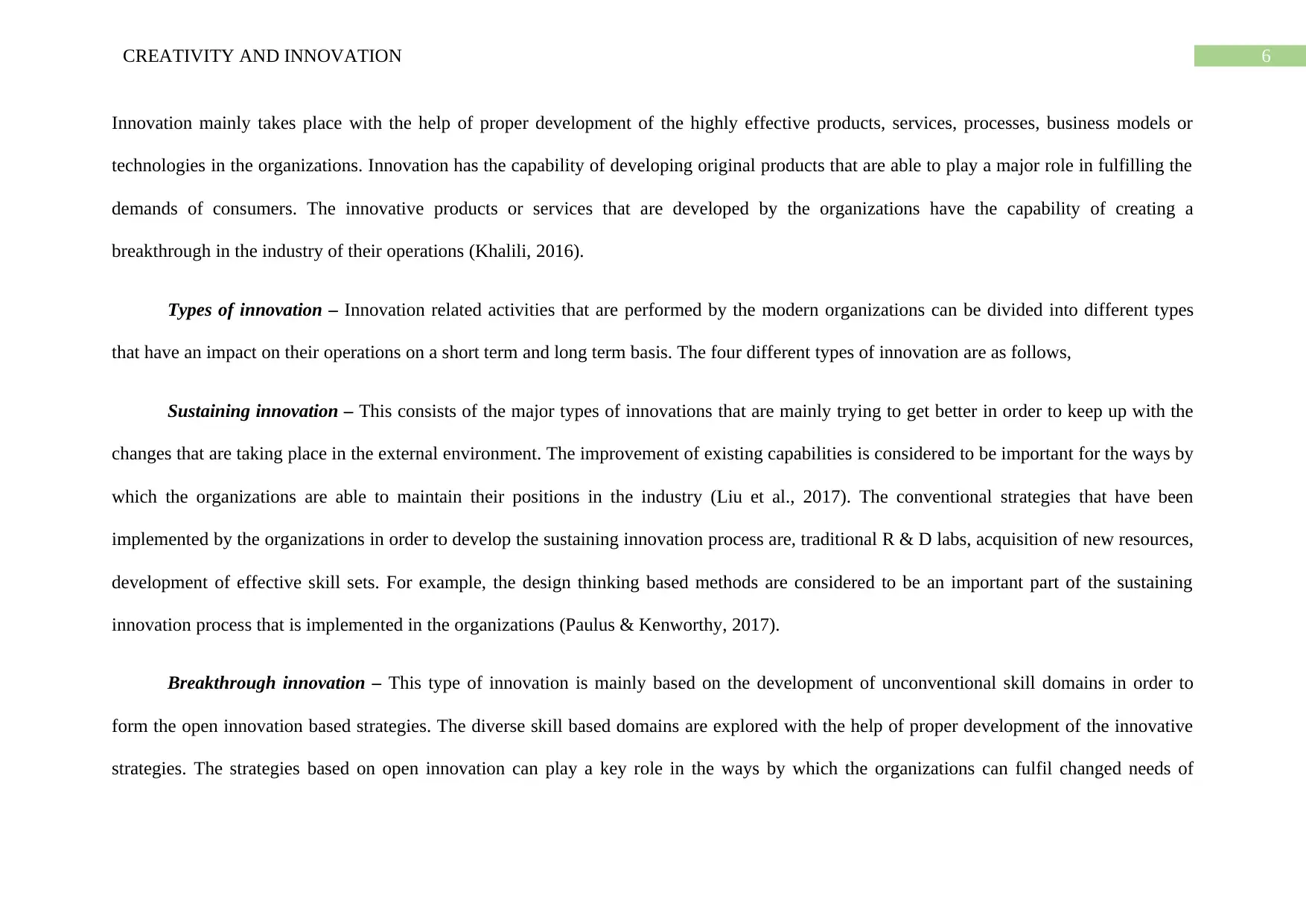
6CREATIVITY AND INNOVATION
Innovation mainly takes place with the help of proper development of the highly effective products, services, processes, business models or
technologies in the organizations. Innovation has the capability of developing original products that are able to play a major role in fulfilling the
demands of consumers. The innovative products or services that are developed by the organizations have the capability of creating a
breakthrough in the industry of their operations (Khalili, 2016).
Types of innovation – Innovation related activities that are performed by the modern organizations can be divided into different types
that have an impact on their operations on a short term and long term basis. The four different types of innovation are as follows,
Sustaining innovation – This consists of the major types of innovations that are mainly trying to get better in order to keep up with the
changes that are taking place in the external environment. The improvement of existing capabilities is considered to be important for the ways by
which the organizations are able to maintain their positions in the industry (Liu et al., 2017). The conventional strategies that have been
implemented by the organizations in order to develop the sustaining innovation process are, traditional R & D labs, acquisition of new resources,
development of effective skill sets. For example, the design thinking based methods are considered to be an important part of the sustaining
innovation process that is implemented in the organizations (Paulus & Kenworthy, 2017).
Breakthrough innovation – This type of innovation is mainly based on the development of unconventional skill domains in order to
form the open innovation based strategies. The diverse skill based domains are explored with the help of proper development of the innovative
strategies. The strategies based on open innovation can play a key role in the ways by which the organizations can fulfil changed needs of
Innovation mainly takes place with the help of proper development of the highly effective products, services, processes, business models or
technologies in the organizations. Innovation has the capability of developing original products that are able to play a major role in fulfilling the
demands of consumers. The innovative products or services that are developed by the organizations have the capability of creating a
breakthrough in the industry of their operations (Khalili, 2016).
Types of innovation – Innovation related activities that are performed by the modern organizations can be divided into different types
that have an impact on their operations on a short term and long term basis. The four different types of innovation are as follows,
Sustaining innovation – This consists of the major types of innovations that are mainly trying to get better in order to keep up with the
changes that are taking place in the external environment. The improvement of existing capabilities is considered to be important for the ways by
which the organizations are able to maintain their positions in the industry (Liu et al., 2017). The conventional strategies that have been
implemented by the organizations in order to develop the sustaining innovation process are, traditional R & D labs, acquisition of new resources,
development of effective skill sets. For example, the design thinking based methods are considered to be an important part of the sustaining
innovation process that is implemented in the organizations (Paulus & Kenworthy, 2017).
Breakthrough innovation – This type of innovation is mainly based on the development of unconventional skill domains in order to
form the open innovation based strategies. The diverse skill based domains are explored with the help of proper development of the innovative
strategies. The strategies based on open innovation can play a key role in the ways by which the organizations can fulfil changed needs of
Paraphrase This Document
Need a fresh take? Get an instant paraphrase of this document with our AI Paraphraser
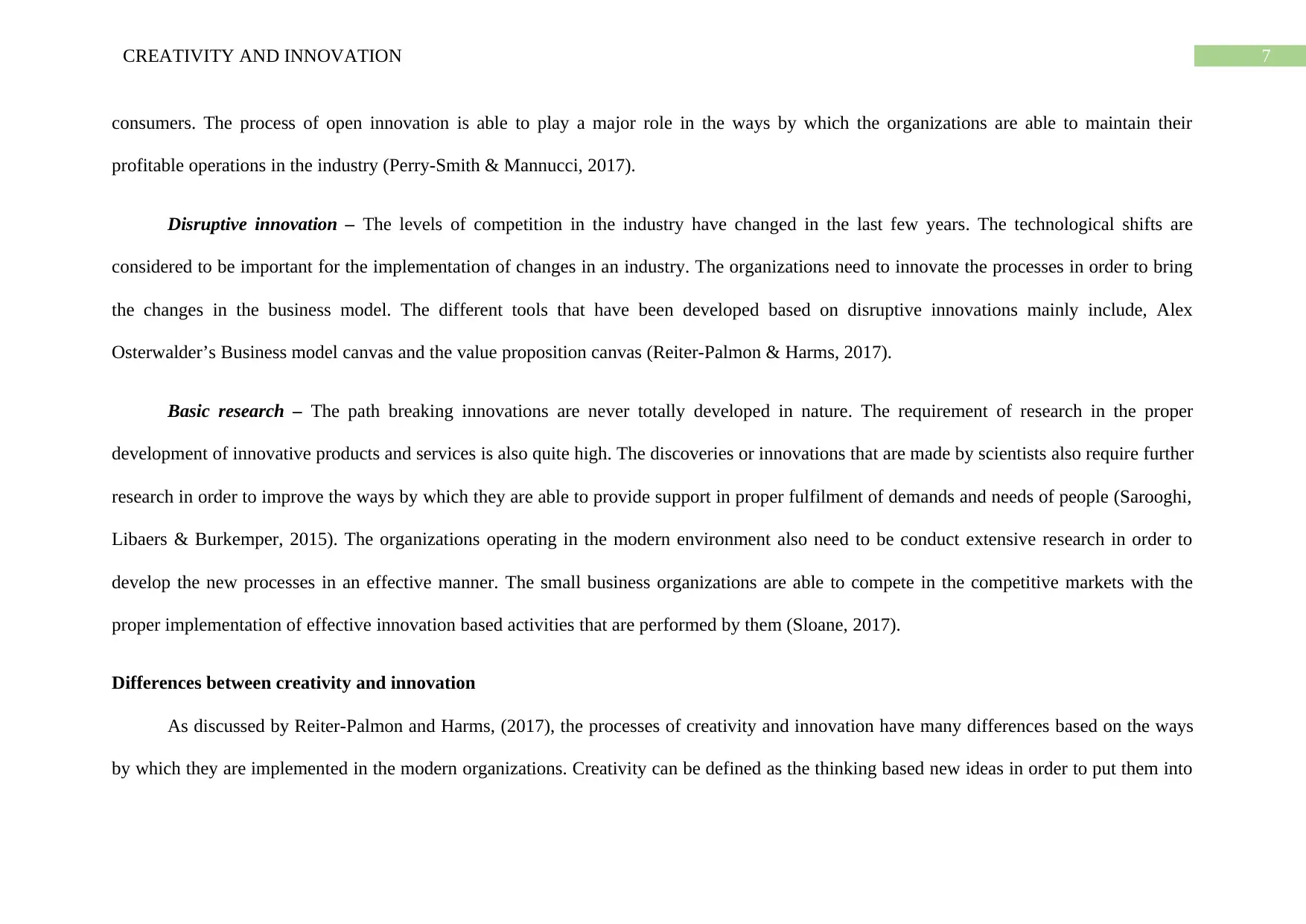
7CREATIVITY AND INNOVATION
consumers. The process of open innovation is able to play a major role in the ways by which the organizations are able to maintain their
profitable operations in the industry (Perry-Smith & Mannucci, 2017).
Disruptive innovation – The levels of competition in the industry have changed in the last few years. The technological shifts are
considered to be important for the implementation of changes in an industry. The organizations need to innovate the processes in order to bring
the changes in the business model. The different tools that have been developed based on disruptive innovations mainly include, Alex
Osterwalder’s Business model canvas and the value proposition canvas (Reiter-Palmon & Harms, 2017).
Basic research – The path breaking innovations are never totally developed in nature. The requirement of research in the proper
development of innovative products and services is also quite high. The discoveries or innovations that are made by scientists also require further
research in order to improve the ways by which they are able to provide support in proper fulfilment of demands and needs of people (Sarooghi,
Libaers & Burkemper, 2015). The organizations operating in the modern environment also need to be conduct extensive research in order to
develop the new processes in an effective manner. The small business organizations are able to compete in the competitive markets with the
proper implementation of effective innovation based activities that are performed by them (Sloane, 2017).
Differences between creativity and innovation
As discussed by Reiter-Palmon and Harms, (2017), the processes of creativity and innovation have many differences based on the ways
by which they are implemented in the modern organizations. Creativity can be defined as the thinking based new ideas in order to put them into
consumers. The process of open innovation is able to play a major role in the ways by which the organizations are able to maintain their
profitable operations in the industry (Perry-Smith & Mannucci, 2017).
Disruptive innovation – The levels of competition in the industry have changed in the last few years. The technological shifts are
considered to be important for the implementation of changes in an industry. The organizations need to innovate the processes in order to bring
the changes in the business model. The different tools that have been developed based on disruptive innovations mainly include, Alex
Osterwalder’s Business model canvas and the value proposition canvas (Reiter-Palmon & Harms, 2017).
Basic research – The path breaking innovations are never totally developed in nature. The requirement of research in the proper
development of innovative products and services is also quite high. The discoveries or innovations that are made by scientists also require further
research in order to improve the ways by which they are able to provide support in proper fulfilment of demands and needs of people (Sarooghi,
Libaers & Burkemper, 2015). The organizations operating in the modern environment also need to be conduct extensive research in order to
develop the new processes in an effective manner. The small business organizations are able to compete in the competitive markets with the
proper implementation of effective innovation based activities that are performed by them (Sloane, 2017).
Differences between creativity and innovation
As discussed by Reiter-Palmon and Harms, (2017), the processes of creativity and innovation have many differences based on the ways
by which they are implemented in the modern organizations. Creativity can be defined as the thinking based new ideas in order to put them into
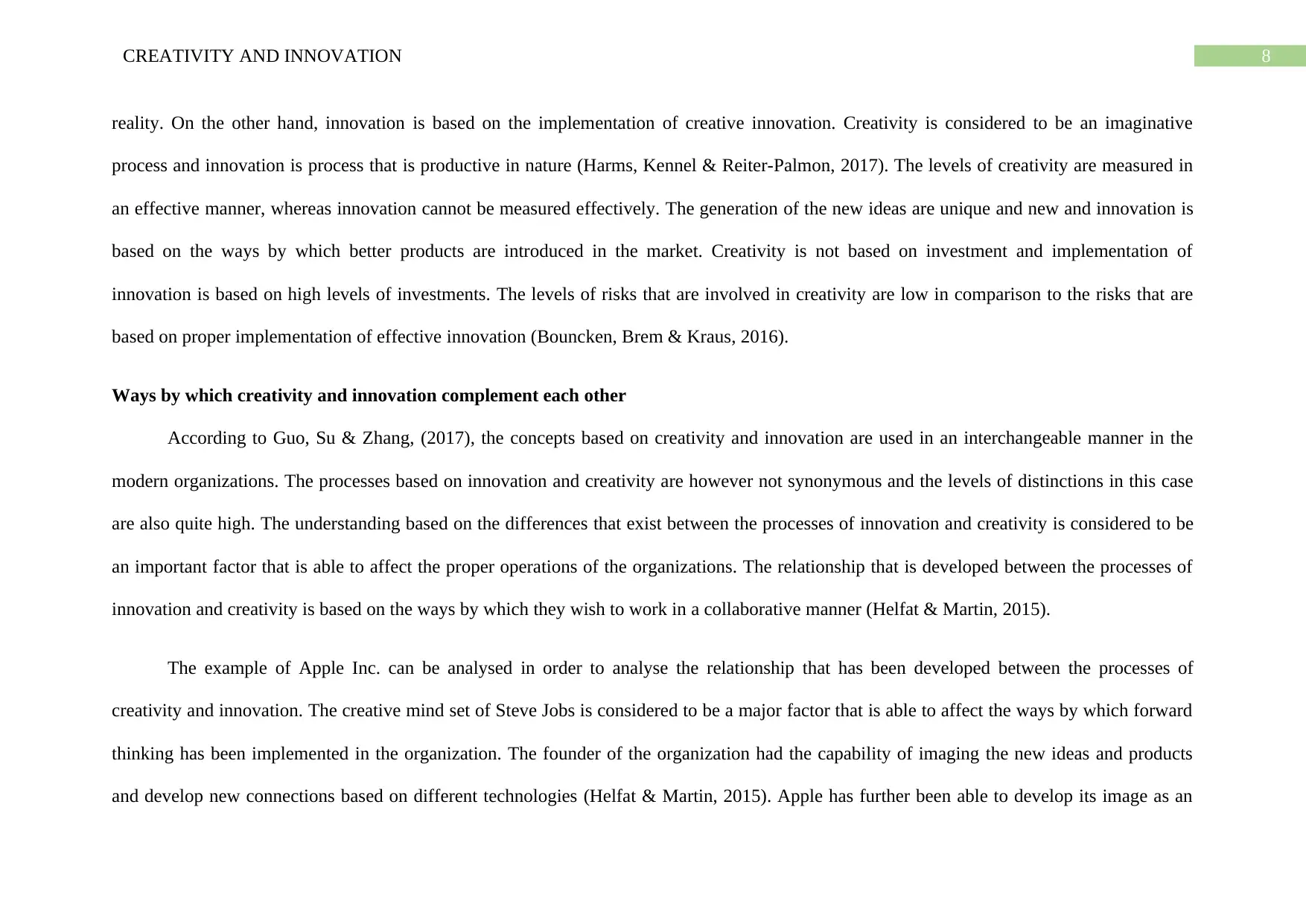
8CREATIVITY AND INNOVATION
reality. On the other hand, innovation is based on the implementation of creative innovation. Creativity is considered to be an imaginative
process and innovation is process that is productive in nature (Harms, Kennel & Reiter-Palmon, 2017). The levels of creativity are measured in
an effective manner, whereas innovation cannot be measured effectively. The generation of the new ideas are unique and new and innovation is
based on the ways by which better products are introduced in the market. Creativity is not based on investment and implementation of
innovation is based on high levels of investments. The levels of risks that are involved in creativity are low in comparison to the risks that are
based on proper implementation of effective innovation (Bouncken, Brem & Kraus, 2016).
Ways by which creativity and innovation complement each other
According to Guo, Su & Zhang, (2017), the concepts based on creativity and innovation are used in an interchangeable manner in the
modern organizations. The processes based on innovation and creativity are however not synonymous and the levels of distinctions in this case
are also quite high. The understanding based on the differences that exist between the processes of innovation and creativity is considered to be
an important factor that is able to affect the proper operations of the organizations. The relationship that is developed between the processes of
innovation and creativity is based on the ways by which they wish to work in a collaborative manner (Helfat & Martin, 2015).
The example of Apple Inc. can be analysed in order to analyse the relationship that has been developed between the processes of
creativity and innovation. The creative mind set of Steve Jobs is considered to be a major factor that is able to affect the ways by which forward
thinking has been implemented in the organization. The founder of the organization had the capability of imaging the new ideas and products
and develop new connections based on different technologies (Helfat & Martin, 2015). Apple has further been able to develop its image as an
reality. On the other hand, innovation is based on the implementation of creative innovation. Creativity is considered to be an imaginative
process and innovation is process that is productive in nature (Harms, Kennel & Reiter-Palmon, 2017). The levels of creativity are measured in
an effective manner, whereas innovation cannot be measured effectively. The generation of the new ideas are unique and new and innovation is
based on the ways by which better products are introduced in the market. Creativity is not based on investment and implementation of
innovation is based on high levels of investments. The levels of risks that are involved in creativity are low in comparison to the risks that are
based on proper implementation of effective innovation (Bouncken, Brem & Kraus, 2016).
Ways by which creativity and innovation complement each other
According to Guo, Su & Zhang, (2017), the concepts based on creativity and innovation are used in an interchangeable manner in the
modern organizations. The processes based on innovation and creativity are however not synonymous and the levels of distinctions in this case
are also quite high. The understanding based on the differences that exist between the processes of innovation and creativity is considered to be
an important factor that is able to affect the proper operations of the organizations. The relationship that is developed between the processes of
innovation and creativity is based on the ways by which they wish to work in a collaborative manner (Helfat & Martin, 2015).
The example of Apple Inc. can be analysed in order to analyse the relationship that has been developed between the processes of
creativity and innovation. The creative mind set of Steve Jobs is considered to be a major factor that is able to affect the ways by which forward
thinking has been implemented in the organization. The founder of the organization had the capability of imaging the new ideas and products
and develop new connections based on different technologies (Helfat & Martin, 2015). Apple has further been able to develop its image as an
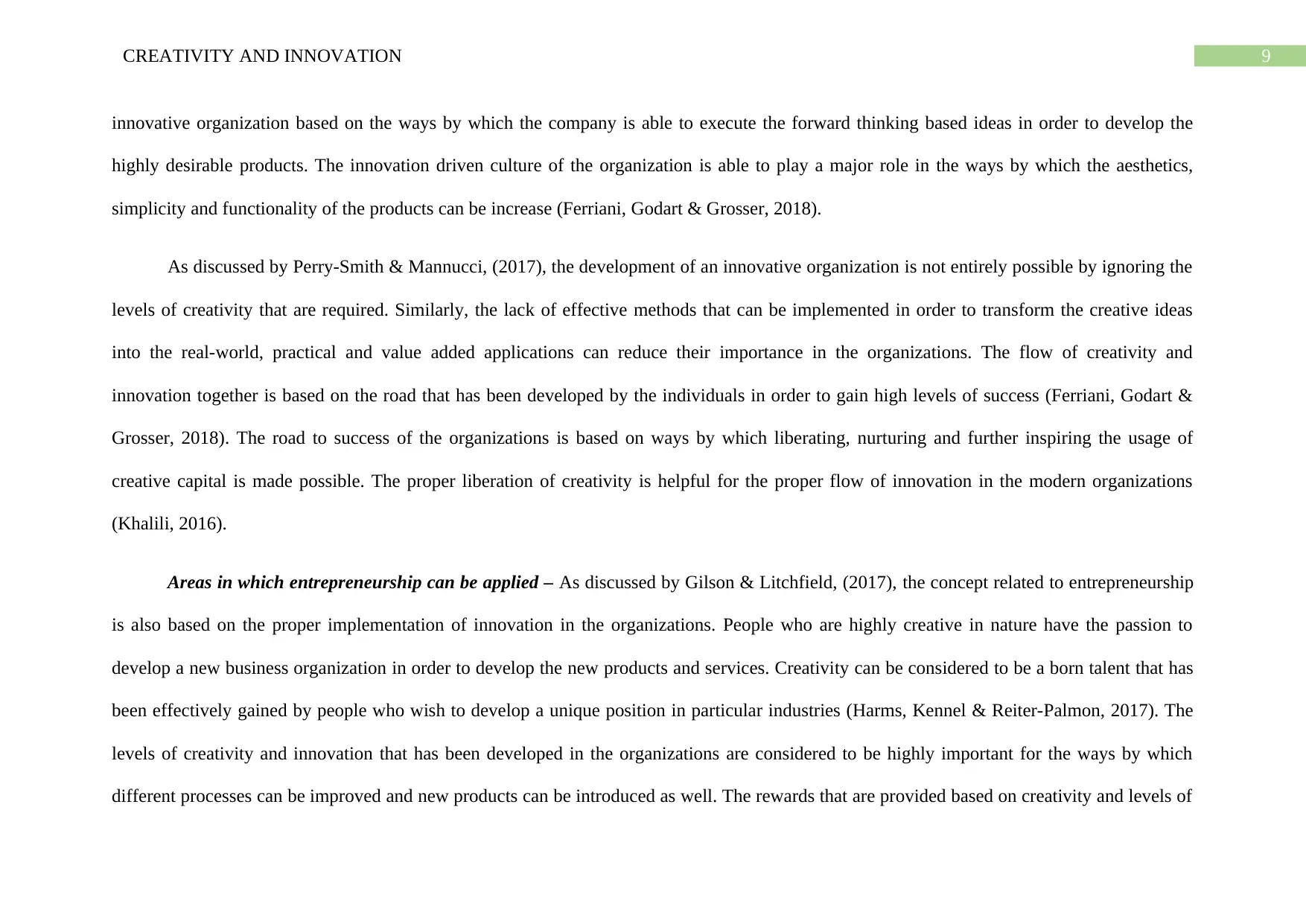
9CREATIVITY AND INNOVATION
innovative organization based on the ways by which the company is able to execute the forward thinking based ideas in order to develop the
highly desirable products. The innovation driven culture of the organization is able to play a major role in the ways by which the aesthetics,
simplicity and functionality of the products can be increase (Ferriani, Godart & Grosser, 2018).
As discussed by Perry-Smith & Mannucci, (2017), the development of an innovative organization is not entirely possible by ignoring the
levels of creativity that are required. Similarly, the lack of effective methods that can be implemented in order to transform the creative ideas
into the real-world, practical and value added applications can reduce their importance in the organizations. The flow of creativity and
innovation together is based on the road that has been developed by the individuals in order to gain high levels of success (Ferriani, Godart &
Grosser, 2018). The road to success of the organizations is based on ways by which liberating, nurturing and further inspiring the usage of
creative capital is made possible. The proper liberation of creativity is helpful for the proper flow of innovation in the modern organizations
(Khalili, 2016).
Areas in which entrepreneurship can be applied – As discussed by Gilson & Litchfield, (2017), the concept related to entrepreneurship
is also based on the proper implementation of innovation in the organizations. People who are highly creative in nature have the passion to
develop a new business organization in order to develop the new products and services. Creativity can be considered to be a born talent that has
been effectively gained by people who wish to develop a unique position in particular industries (Harms, Kennel & Reiter-Palmon, 2017). The
levels of creativity and innovation that has been developed in the organizations are considered to be highly important for the ways by which
different processes can be improved and new products can be introduced as well. The rewards that are provided based on creativity and levels of
innovative organization based on the ways by which the company is able to execute the forward thinking based ideas in order to develop the
highly desirable products. The innovation driven culture of the organization is able to play a major role in the ways by which the aesthetics,
simplicity and functionality of the products can be increase (Ferriani, Godart & Grosser, 2018).
As discussed by Perry-Smith & Mannucci, (2017), the development of an innovative organization is not entirely possible by ignoring the
levels of creativity that are required. Similarly, the lack of effective methods that can be implemented in order to transform the creative ideas
into the real-world, practical and value added applications can reduce their importance in the organizations. The flow of creativity and
innovation together is based on the road that has been developed by the individuals in order to gain high levels of success (Ferriani, Godart &
Grosser, 2018). The road to success of the organizations is based on ways by which liberating, nurturing and further inspiring the usage of
creative capital is made possible. The proper liberation of creativity is helpful for the proper flow of innovation in the modern organizations
(Khalili, 2016).
Areas in which entrepreneurship can be applied – As discussed by Gilson & Litchfield, (2017), the concept related to entrepreneurship
is also based on the proper implementation of innovation in the organizations. People who are highly creative in nature have the passion to
develop a new business organization in order to develop the new products and services. Creativity can be considered to be a born talent that has
been effectively gained by people who wish to develop a unique position in particular industries (Harms, Kennel & Reiter-Palmon, 2017). The
levels of creativity and innovation that has been developed in the organizations are considered to be highly important for the ways by which
different processes can be improved and new products can be introduced as well. The rewards that are provided based on creativity and levels of
Secure Best Marks with AI Grader
Need help grading? Try our AI Grader for instant feedback on your assignments.
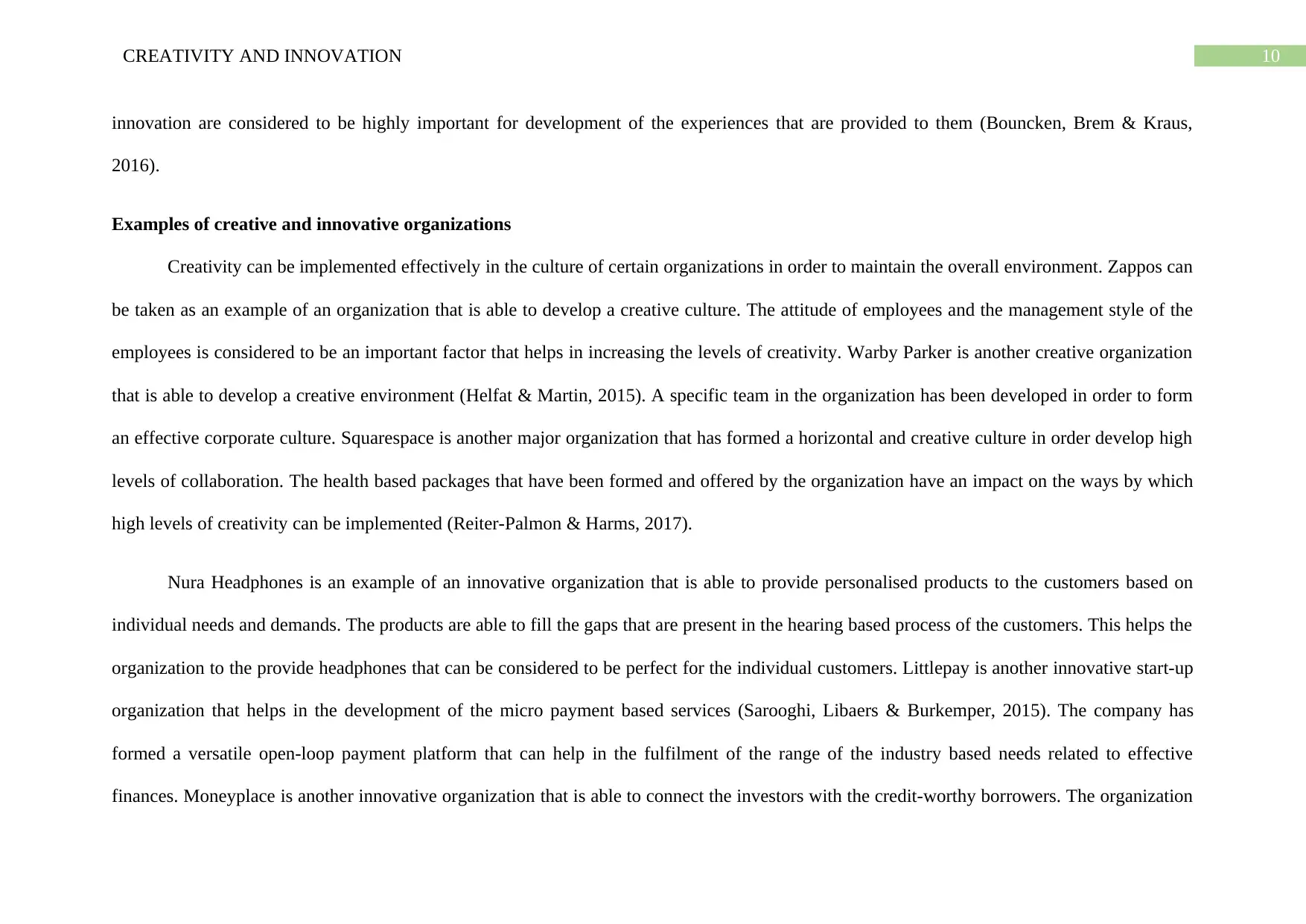
10CREATIVITY AND INNOVATION
innovation are considered to be highly important for development of the experiences that are provided to them (Bouncken, Brem & Kraus,
2016).
Examples of creative and innovative organizations
Creativity can be implemented effectively in the culture of certain organizations in order to maintain the overall environment. Zappos can
be taken as an example of an organization that is able to develop a creative culture. The attitude of employees and the management style of the
employees is considered to be an important factor that helps in increasing the levels of creativity. Warby Parker is another creative organization
that is able to develop a creative environment (Helfat & Martin, 2015). A specific team in the organization has been developed in order to form
an effective corporate culture. Squarespace is another major organization that has formed a horizontal and creative culture in order develop high
levels of collaboration. The health based packages that have been formed and offered by the organization have an impact on the ways by which
high levels of creativity can be implemented (Reiter-Palmon & Harms, 2017).
Nura Headphones is an example of an innovative organization that is able to provide personalised products to the customers based on
individual needs and demands. The products are able to fill the gaps that are present in the hearing based process of the customers. This helps the
organization to the provide headphones that can be considered to be perfect for the individual customers. Littlepay is another innovative start-up
organization that helps in the development of the micro payment based services (Sarooghi, Libaers & Burkemper, 2015). The company has
formed a versatile open-loop payment platform that can help in the fulfilment of the range of the industry based needs related to effective
finances. Moneyplace is another innovative organization that is able to connect the investors with the credit-worthy borrowers. The organization
innovation are considered to be highly important for development of the experiences that are provided to them (Bouncken, Brem & Kraus,
2016).
Examples of creative and innovative organizations
Creativity can be implemented effectively in the culture of certain organizations in order to maintain the overall environment. Zappos can
be taken as an example of an organization that is able to develop a creative culture. The attitude of employees and the management style of the
employees is considered to be an important factor that helps in increasing the levels of creativity. Warby Parker is another creative organization
that is able to develop a creative environment (Helfat & Martin, 2015). A specific team in the organization has been developed in order to form
an effective corporate culture. Squarespace is another major organization that has formed a horizontal and creative culture in order develop high
levels of collaboration. The health based packages that have been formed and offered by the organization have an impact on the ways by which
high levels of creativity can be implemented (Reiter-Palmon & Harms, 2017).
Nura Headphones is an example of an innovative organization that is able to provide personalised products to the customers based on
individual needs and demands. The products are able to fill the gaps that are present in the hearing based process of the customers. This helps the
organization to the provide headphones that can be considered to be perfect for the individual customers. Littlepay is another innovative start-up
organization that helps in the development of the micro payment based services (Sarooghi, Libaers & Burkemper, 2015). The company has
formed a versatile open-loop payment platform that can help in the fulfilment of the range of the industry based needs related to effective
finances. Moneyplace is another innovative organization that is able to connect the investors with the credit-worthy borrowers. The organization
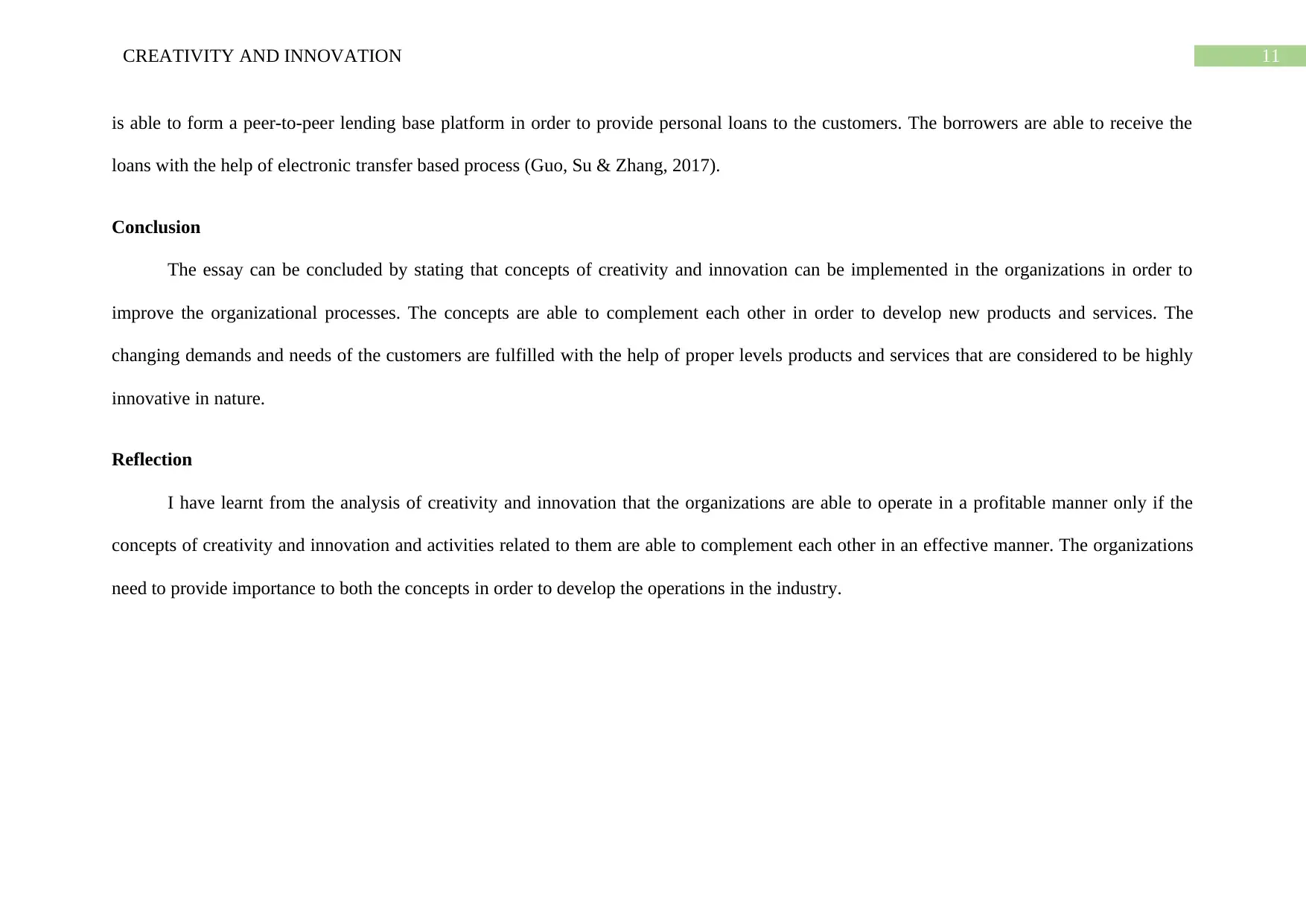
11CREATIVITY AND INNOVATION
is able to form a peer-to-peer lending base platform in order to provide personal loans to the customers. The borrowers are able to receive the
loans with the help of electronic transfer based process (Guo, Su & Zhang, 2017).
Conclusion
The essay can be concluded by stating that concepts of creativity and innovation can be implemented in the organizations in order to
improve the organizational processes. The concepts are able to complement each other in order to develop new products and services. The
changing demands and needs of the customers are fulfilled with the help of proper levels products and services that are considered to be highly
innovative in nature.
Reflection
I have learnt from the analysis of creativity and innovation that the organizations are able to operate in a profitable manner only if the
concepts of creativity and innovation and activities related to them are able to complement each other in an effective manner. The organizations
need to provide importance to both the concepts in order to develop the operations in the industry.
is able to form a peer-to-peer lending base platform in order to provide personal loans to the customers. The borrowers are able to receive the
loans with the help of electronic transfer based process (Guo, Su & Zhang, 2017).
Conclusion
The essay can be concluded by stating that concepts of creativity and innovation can be implemented in the organizations in order to
improve the organizational processes. The concepts are able to complement each other in order to develop new products and services. The
changing demands and needs of the customers are fulfilled with the help of proper levels products and services that are considered to be highly
innovative in nature.
Reflection
I have learnt from the analysis of creativity and innovation that the organizations are able to operate in a profitable manner only if the
concepts of creativity and innovation and activities related to them are able to complement each other in an effective manner. The organizations
need to provide importance to both the concepts in order to develop the operations in the industry.
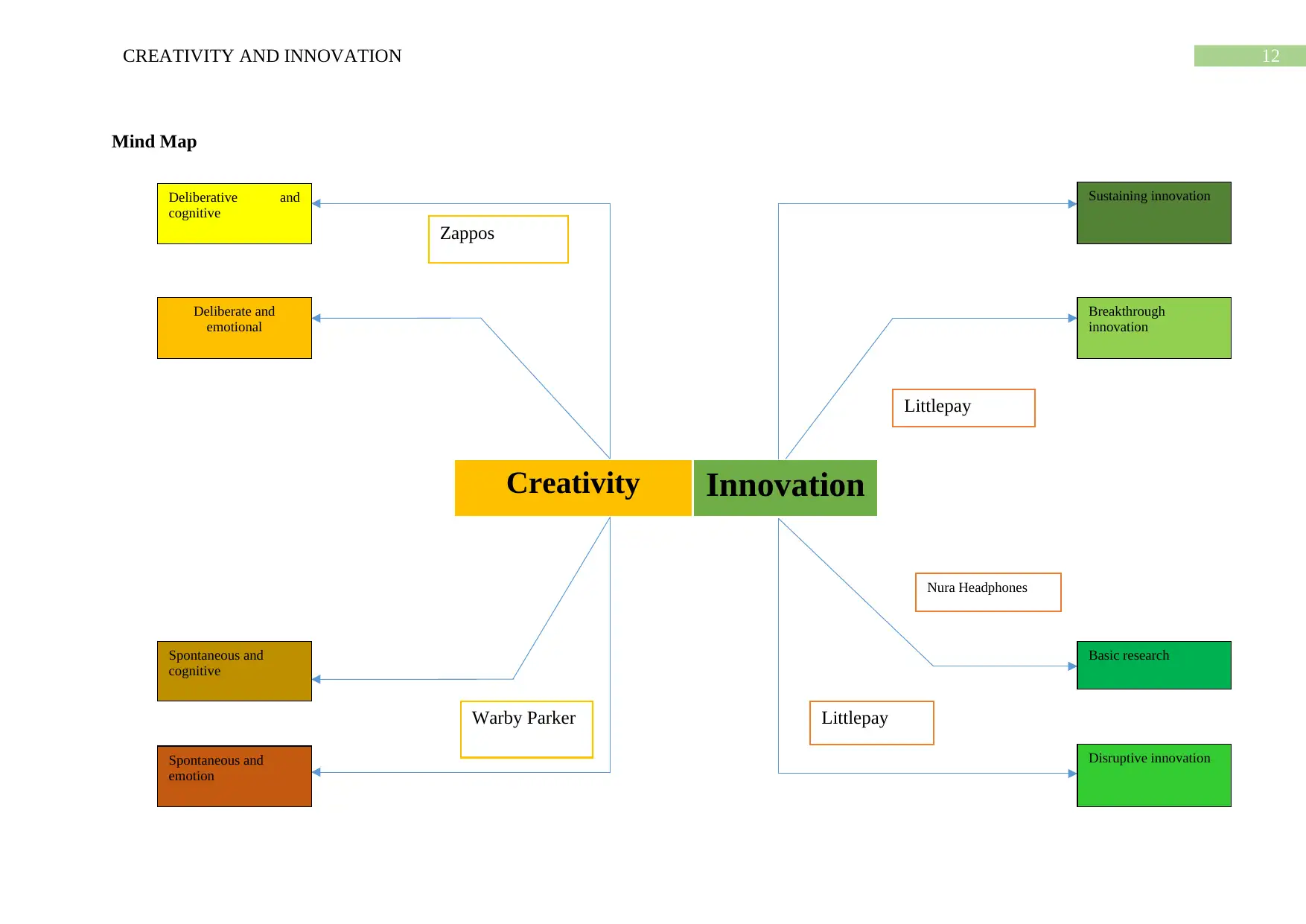
12CREATIVITY AND INNOVATION
Creativity Innovation
Deliberative and
cognitive
Spontaneous and
cognitive
Deliberate and
emotional
Disruptive innovation
Basic research
Breakthrough
innovation
Sustaining innovation
Spontaneous and
emotion
Zappos
Warby Parker
Littlepay
Nura Headphones
Littlepay
Mind Map
Creativity Innovation
Deliberative and
cognitive
Spontaneous and
cognitive
Deliberate and
emotional
Disruptive innovation
Basic research
Breakthrough
innovation
Sustaining innovation
Spontaneous and
emotion
Zappos
Warby Parker
Littlepay
Nura Headphones
Littlepay
Mind Map
Paraphrase This Document
Need a fresh take? Get an instant paraphrase of this document with our AI Paraphraser
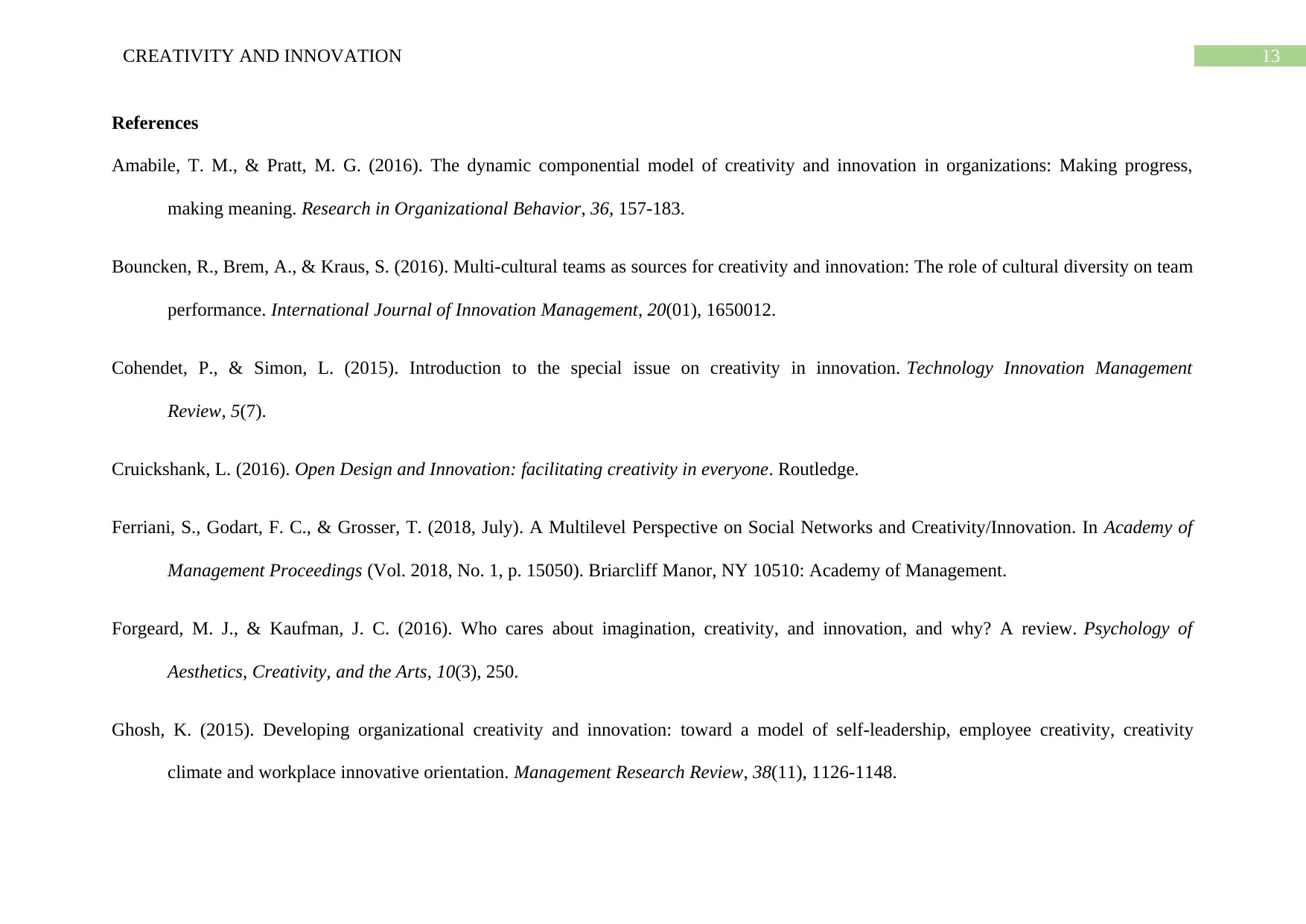
13CREATIVITY AND INNOVATION
References
Amabile, T. M., & Pratt, M. G. (2016). The dynamic componential model of creativity and innovation in organizations: Making progress,
making meaning. Research in Organizational Behavior, 36, 157-183.
Bouncken, R., Brem, A., & Kraus, S. (2016). Multi-cultural teams as sources for creativity and innovation: The role of cultural diversity on team
performance. International Journal of Innovation Management, 20(01), 1650012.
Cohendet, P., & Simon, L. (2015). Introduction to the special issue on creativity in innovation. Technology Innovation Management
Review, 5(7).
Cruickshank, L. (2016). Open Design and Innovation: facilitating creativity in everyone. Routledge.
Ferriani, S., Godart, F. C., & Grosser, T. (2018, July). A Multilevel Perspective on Social Networks and Creativity/Innovation. In Academy of
Management Proceedings (Vol. 2018, No. 1, p. 15050). Briarcliff Manor, NY 10510: Academy of Management.
Forgeard, M. J., & Kaufman, J. C. (2016). Who cares about imagination, creativity, and innovation, and why? A review. Psychology of
Aesthetics, Creativity, and the Arts, 10(3), 250.
Ghosh, K. (2015). Developing organizational creativity and innovation: toward a model of self-leadership, employee creativity, creativity
climate and workplace innovative orientation. Management Research Review, 38(11), 1126-1148.
References
Amabile, T. M., & Pratt, M. G. (2016). The dynamic componential model of creativity and innovation in organizations: Making progress,
making meaning. Research in Organizational Behavior, 36, 157-183.
Bouncken, R., Brem, A., & Kraus, S. (2016). Multi-cultural teams as sources for creativity and innovation: The role of cultural diversity on team
performance. International Journal of Innovation Management, 20(01), 1650012.
Cohendet, P., & Simon, L. (2015). Introduction to the special issue on creativity in innovation. Technology Innovation Management
Review, 5(7).
Cruickshank, L. (2016). Open Design and Innovation: facilitating creativity in everyone. Routledge.
Ferriani, S., Godart, F. C., & Grosser, T. (2018, July). A Multilevel Perspective on Social Networks and Creativity/Innovation. In Academy of
Management Proceedings (Vol. 2018, No. 1, p. 15050). Briarcliff Manor, NY 10510: Academy of Management.
Forgeard, M. J., & Kaufman, J. C. (2016). Who cares about imagination, creativity, and innovation, and why? A review. Psychology of
Aesthetics, Creativity, and the Arts, 10(3), 250.
Ghosh, K. (2015). Developing organizational creativity and innovation: toward a model of self-leadership, employee creativity, creativity
climate and workplace innovative orientation. Management Research Review, 38(11), 1126-1148.
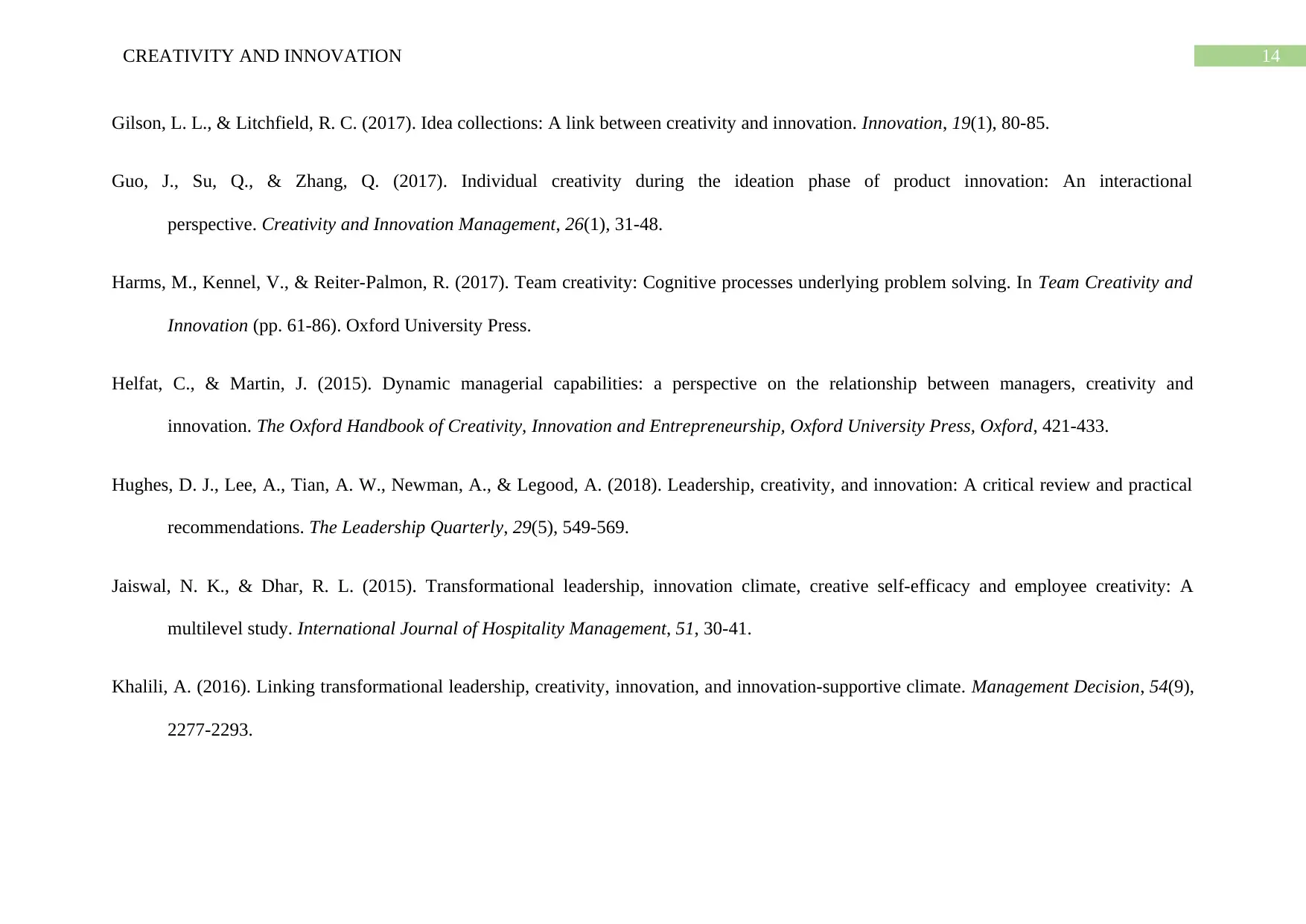
14CREATIVITY AND INNOVATION
Gilson, L. L., & Litchfield, R. C. (2017). Idea collections: A link between creativity and innovation. Innovation, 19(1), 80-85.
Guo, J., Su, Q., & Zhang, Q. (2017). Individual creativity during the ideation phase of product innovation: An interactional
perspective. Creativity and Innovation Management, 26(1), 31-48.
Harms, M., Kennel, V., & Reiter-Palmon, R. (2017). Team creativity: Cognitive processes underlying problem solving. In Team Creativity and
Innovation (pp. 61-86). Oxford University Press.
Helfat, C., & Martin, J. (2015). Dynamic managerial capabilities: a perspective on the relationship between managers, creativity and
innovation. The Oxford Handbook of Creativity, Innovation and Entrepreneurship, Oxford University Press, Oxford, 421-433.
Hughes, D. J., Lee, A., Tian, A. W., Newman, A., & Legood, A. (2018). Leadership, creativity, and innovation: A critical review and practical
recommendations. The Leadership Quarterly, 29(5), 549-569.
Jaiswal, N. K., & Dhar, R. L. (2015). Transformational leadership, innovation climate, creative self-efficacy and employee creativity: A
multilevel study. International Journal of Hospitality Management, 51, 30-41.
Khalili, A. (2016). Linking transformational leadership, creativity, innovation, and innovation-supportive climate. Management Decision, 54(9),
2277-2293.
Gilson, L. L., & Litchfield, R. C. (2017). Idea collections: A link between creativity and innovation. Innovation, 19(1), 80-85.
Guo, J., Su, Q., & Zhang, Q. (2017). Individual creativity during the ideation phase of product innovation: An interactional
perspective. Creativity and Innovation Management, 26(1), 31-48.
Harms, M., Kennel, V., & Reiter-Palmon, R. (2017). Team creativity: Cognitive processes underlying problem solving. In Team Creativity and
Innovation (pp. 61-86). Oxford University Press.
Helfat, C., & Martin, J. (2015). Dynamic managerial capabilities: a perspective on the relationship between managers, creativity and
innovation. The Oxford Handbook of Creativity, Innovation and Entrepreneurship, Oxford University Press, Oxford, 421-433.
Hughes, D. J., Lee, A., Tian, A. W., Newman, A., & Legood, A. (2018). Leadership, creativity, and innovation: A critical review and practical
recommendations. The Leadership Quarterly, 29(5), 549-569.
Jaiswal, N. K., & Dhar, R. L. (2015). Transformational leadership, innovation climate, creative self-efficacy and employee creativity: A
multilevel study. International Journal of Hospitality Management, 51, 30-41.
Khalili, A. (2016). Linking transformational leadership, creativity, innovation, and innovation-supportive climate. Management Decision, 54(9),
2277-2293.
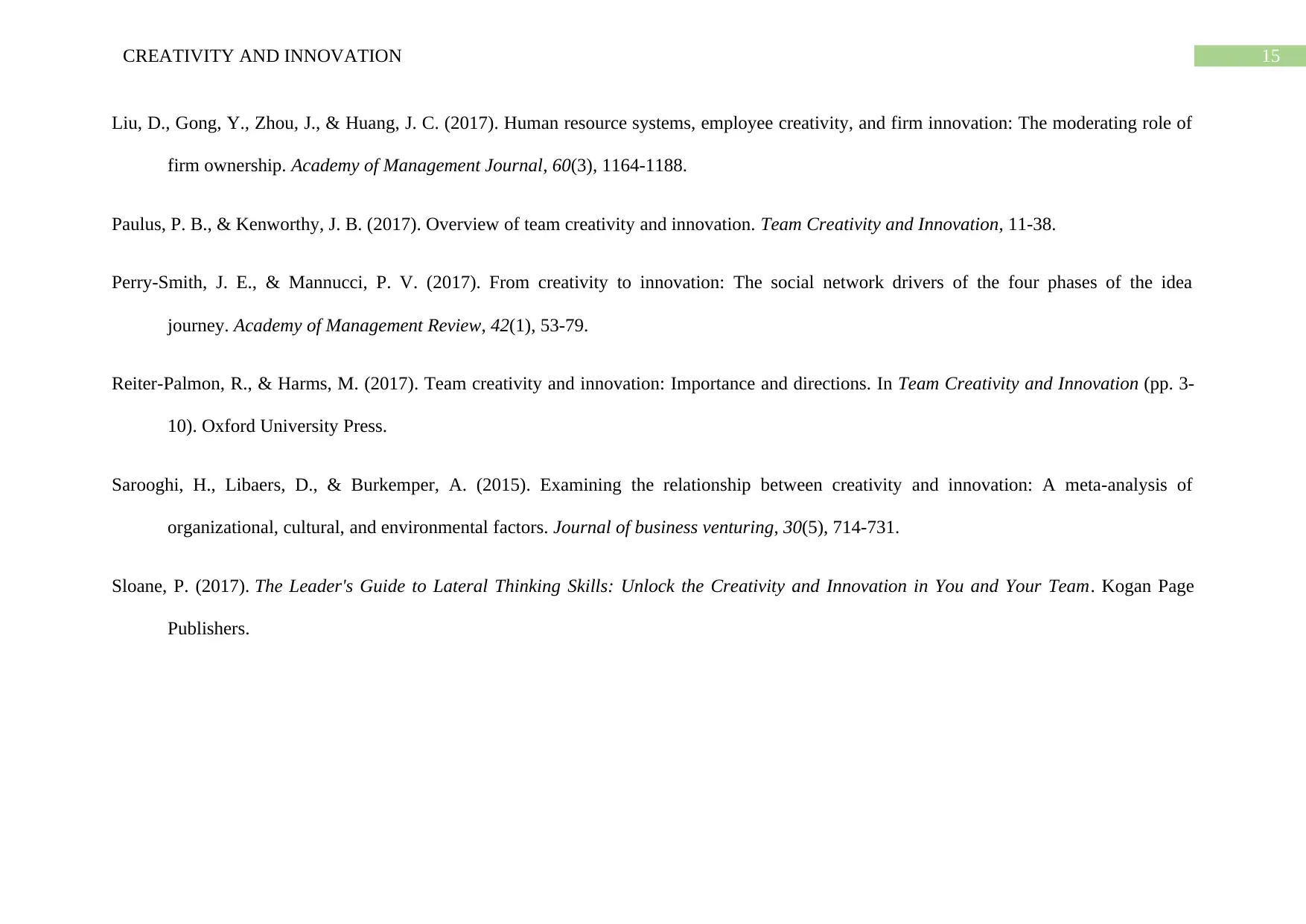
15CREATIVITY AND INNOVATION
Liu, D., Gong, Y., Zhou, J., & Huang, J. C. (2017). Human resource systems, employee creativity, and firm innovation: The moderating role of
firm ownership. Academy of Management Journal, 60(3), 1164-1188.
Paulus, P. B., & Kenworthy, J. B. (2017). Overview of team creativity and innovation. Team Creativity and Innovation, 11-38.
Perry-Smith, J. E., & Mannucci, P. V. (2017). From creativity to innovation: The social network drivers of the four phases of the idea
journey. Academy of Management Review, 42(1), 53-79.
Reiter-Palmon, R., & Harms, M. (2017). Team creativity and innovation: Importance and directions. In Team Creativity and Innovation (pp. 3-
10). Oxford University Press.
Sarooghi, H., Libaers, D., & Burkemper, A. (2015). Examining the relationship between creativity and innovation: A meta-analysis of
organizational, cultural, and environmental factors. Journal of business venturing, 30(5), 714-731.
Sloane, P. (2017). The Leader's Guide to Lateral Thinking Skills: Unlock the Creativity and Innovation in You and Your Team. Kogan Page
Publishers.
Liu, D., Gong, Y., Zhou, J., & Huang, J. C. (2017). Human resource systems, employee creativity, and firm innovation: The moderating role of
firm ownership. Academy of Management Journal, 60(3), 1164-1188.
Paulus, P. B., & Kenworthy, J. B. (2017). Overview of team creativity and innovation. Team Creativity and Innovation, 11-38.
Perry-Smith, J. E., & Mannucci, P. V. (2017). From creativity to innovation: The social network drivers of the four phases of the idea
journey. Academy of Management Review, 42(1), 53-79.
Reiter-Palmon, R., & Harms, M. (2017). Team creativity and innovation: Importance and directions. In Team Creativity and Innovation (pp. 3-
10). Oxford University Press.
Sarooghi, H., Libaers, D., & Burkemper, A. (2015). Examining the relationship between creativity and innovation: A meta-analysis of
organizational, cultural, and environmental factors. Journal of business venturing, 30(5), 714-731.
Sloane, P. (2017). The Leader's Guide to Lateral Thinking Skills: Unlock the Creativity and Innovation in You and Your Team. Kogan Page
Publishers.
1 out of 16
Related Documents
Your All-in-One AI-Powered Toolkit for Academic Success.
+13062052269
info@desklib.com
Available 24*7 on WhatsApp / Email
![[object Object]](/_next/static/media/star-bottom.7253800d.svg)
Unlock your academic potential
© 2024 | Zucol Services PVT LTD | All rights reserved.





